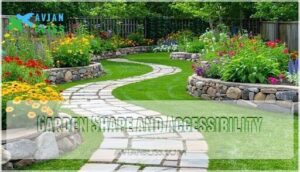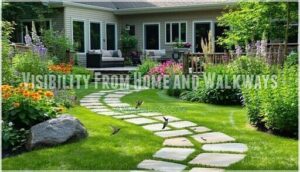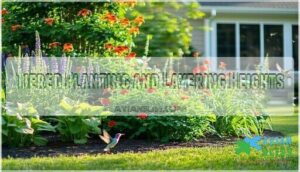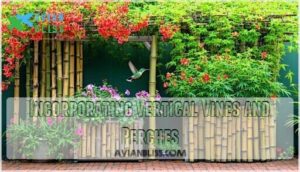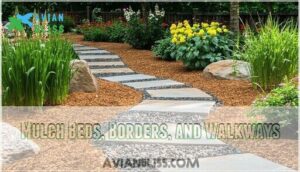This site is supported by our readers. We may earn a commission, at no cost to you, if you purchase through links.
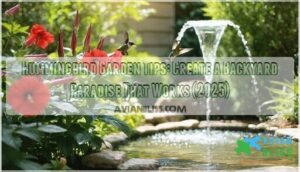 A hummingbird garden combines nectar-rich native plants, water features, and layered vegetation to create an irresistible habitat for these tiny aerial acrobats.
A hummingbird garden combines nectar-rich native plants, water features, and layered vegetation to create an irresistible habitat for these tiny aerial acrobats.
You’ll need tubular, red flowers like bee balm and cardinal flower that bloom continuously throughout the season. Add shallow fountains or misters for drinking and bathing, plus perching spots at different heights.
Avoid pesticides since hummingbirds eat small insects for protein. Place your garden where you can watch from windows, with some wind protection and both sunny and partially shaded areas.
The magic happens when you understand that successful hummingbird gardens aren’t just about pretty flowers—they’re complete ecosystems designed around these remarkable birds’ specific survival needs.
Table Of Contents
- Key Takeaways
- What is a Hummingbird Garden?
- Choosing The Best Location and Layout
- Selecting Plants That Attract Hummingbirds
- Designing a Hummingbird-Friendly Habitat
- Providing Water, Shelter, and Nesting Sites
- Maintaining and Enhancing Your Garden
- Frequently Asked Questions (FAQs)
- How to set up a hummingbird garden?
- What is a hummingbird garden?
- What is the best plant for hummingbirds?
- What attracts hummingbirds the most?
- How do hummingbirds find new gardens?
- Can hummingbirds become dependent on artificial feeders?
- Do hummingbirds remember and revisit specific gardens?
- How do weather conditions affect hummingbird garden activity?
- Are there specific times of day hummingbirds prefer feeding?
- How often should hummingbird feeders be cleaned?
- Conclusion
Key Takeaways
- Choose native, tubular red flowers like bee balm and cardinal flower that bloom continuously throughout the season—they’ll provide 2.5 times more nectar than exotic alternatives and keep hummingbirds coming back all year long.
- Layer your garden with heights and water features by positioning tall plants in back, medium shrubs in the middle, and low perennials up front, then add shallow fountains or misters since moving water attracts 65% more visitors than static sources.
- Skip the pesticides and maintain clean feeders because hummingbirds need small insects for protein, and dirty feeders can harbor deadly bacteria—clean them every 2-3 days in hot weather with hot water and vinegar.
- Create perching spots and wind protection by spacing thin branches 2 feet apart near your nectar sources and using garden fencing or dense plants as windbreaks to give these territorial birds safe resting areas between feeding sessions.
What is a Hummingbird Garden?
A hummingbird garden creates a specialized habitat filled with nectar-rich flowers and features that attract these tiny birds to your yard.
You’ll design a space that provides food, water, and shelter while giving you front-row seats to watch nature’s smallest acrobats zip around your landscape.
Definition and Purpose
A hummingbird garden creates a specialized outdoor space designed specifically for attracting hummingbirds through targeted plant selection and strategic habitat features.
You’re basically building a nectar-rich paradise that supports these tiny aerial acrobats throughout their feeding cycles and migration patterns.
Here are the key elements that define an effective hummingbird garden:
- Native nectar plants with tubular, red flowers that provide consistent food sources
- Layered vegetation offering perching spots, shelter, and territorial advantages
- Water features like misters or shallow fountains for drinking and bathing
- Pesticide-free environment protecting both hummingbirds and their insect prey
- Year-round blooming schedule supporting resident and migrating species
To further enhance the environment, consider adding DIY nesting platforms to encourage breeding.
Benefits for Hummingbirds and People
Beyond creating a pretty garden, you’ll discover multiple rewards from attracting hummingbirds to your yard.
These tiny birds provide natural pest control by eating flies, gnats, and mosquitoes while supporting ecosystem balance through pollination.
Your hummingbird habitat offers stress reduction as you watch their graceful movements, plus educational value for family members.
Community building happens naturally when neighbors share gardening tips and celebrate these remarkable visitors together, fostering a sense of community building.
Key Elements and Features
Your Garden Essentials create the foundation for successful Hummingbird Garden Design through strategic Feature Integration.
Nectar-rich flowers, reliable Water Sources, and accessible Nesting Material form your habitat’s core.
Design Harmony emerges when you balance flowering plants with perching spots and feeding stations.
Element Functionality peaks through thoughtful placement—feeders near flowers, misters by perches.
This Impact Maximization transforms ordinary spaces into thriving Hummingbird Habitat sanctuaries.
Choosing The Best Location and Layout
You’ll need to pick the perfect spot before planting a single flower if you want hummingbirds to actually visit your garden.
The right location combines full sun exposure with easy access from your home, creating a feeding haven that both you and the birds can enjoy year-round.
Sun and Shade Requirements
Most successful hummingbird gardens balance full sun with partial shade areas.
You’ll want to create diverse microclimates that support both sun-loving blooms and provide shaded refuges for hummingbirds to rest between feeding sessions.
- Light Exposure Assessment – Map your yard’s sun patterns throughout the day to identify ideal plant placement zones
- Sun-Loving Blooms – Position nectar-rich flowers like bee balm and salvia in areas receiving 6+ hours of direct sunlight
- Shaded Refuges – Create cooler rest areas with partial shade where hummingbirds can perch and digest between visits
- Microclimates – Use existing structures like fences or trees to naturally divide your hummingbird garden design into sun and shade sections
Garden Shape and Accessibility
Curved pathways create visual appeal while offering hummingbirds multiple approach angles to your garden.
Design narrow gardens for easier access, incorporating gentle curves that boost sighting rates by 32%.
Add garden borders like rocks or raised beds to define spaces.
Consider accessible design with walkway materials that won’t become slippery, ensuring your hummingbird garden remains both beautiful and functional year-round.
Visibility From Home and Walkways
When you position your hummingbird garden within clear sight lines from windows, decks, or patios, you’ll maximize garden observation opportunities.
Strategic placement near walkways with accessible design guarantees easy maintenance while creating perfect viewing angles.
Choose pathway materials that complement your garden design without overwhelming the delicate beauty that makes attracting hummingbirds so rewarding, ensuring a harmonious balance that enhances the overall beauty.
Wind Protection and Safety
Strong winds can turn your hummingbird garden into a flight hazard zone.
Position wind barriers like garden fencing or dense native plants around exposed areas to create sheltered layouts.
Stake tall flowers in your mulch bed to prevent toppling.
Consider bird collision risks near water features by placing them away from reflective surfaces and glass windows for safer garden design.
Selecting Plants That Attract Hummingbirds
You’ll want to choose plants that produce the nectar hummingbirds crave most.
Focus on native species with tubular red flowers that bloom throughout the growing season to keep these tiny visitors coming back all year long.
Native Nectar-Rich Flowers
Native species create a powerhouse of nectar production that outperforms exotic alternatives by 2.5 times.
Native plants deliver unmatched nectar power—2.5 times stronger than exotic alternatives for hungry hummingbirds
Bee Balm, Cardinal Flower, and Columbine deliver the highest sugar concentrations that fuel hummingbird metabolism.
These native plants bloom longer, require less water, and support natural bloom cycles.
Choose regionally adapted flowers for maximum success.
For ideal results, consider using native plant guides to select the best species for your area, ensuring maximum success with regionally adapted flowers.
Tubular and Red Flower Varieties
Picture hummingbirds hovering like tiny helicopters around your garden’s star performers.
Red Salvia, Bee Balm, and Cardinal Flowers deliver the tubular blooms these ruby-throated hummers crave most.
Long tubular flowers like Trumpet Vine provide abundant nectar that’s perfectly sized for their needle-like beaks.
These hummingbird flowers create an irresistible buffet that’ll have visitors returning daily.
Continuous Blooming Strategies
You’ll create year-round nectar sources through succession planting and bloom scheduling.
Plant early bloomers like columbine, mid-season bee balm, and late cardinal flower for continuous flowering plants for food.
This layering blooms strategy with different bloom times guarantees tubular flowers are always available.
Flower rotation and seasonal planning maintains steady nectar sources, supporting hummingbirds from spring through fall.
Planting Zones and Online Sources
Check your local planting zones before buying plants online.
Zones 4-9 support most hummingbird favorites like bee balm and cardinal flower.
Online nurseries such as American Meadows and Nature Hills offer zone mapping tools and plant guides.
Their garden plans help you choose regional blooms that’ll thrive in your climate, and gardening forums provide real-world advice for success.
Designing a Hummingbird-Friendly Habitat
Creating a well-designed habitat layout transforms your space into a hummingbird magnet that keeps these tiny birds coming back season after season.
You’ll need to think like an architect, arranging plants in layers and clusters that give hummingbirds easy access to nectar while providing the perching spots and flight corridors they crave.
Tiered Planting and Layering Heights
Three-tiered layered garden beds create the perfect hummingbird feeding station.
Position tall plants like trumpet vine in back, medium shrubs like bee balm in middle, and low perennials up front.
This vertical planting approach with height variation gives hummingbirds multiple flight paths and feeding levels.
Garden stratification maximizes your space while supporting diverse native plants you’ll find online.
By incorporating native plants that provide bird friendly gardening techniques, you can create a thriving ecosystem that attracts a variety of bird species, using native plants and bird friendly methods to support local wildlife.
Creating Flower Clusters and Corridors
Group your hummingbird flowers in clusters of three or more plants for maximum visual impact and nectar source management.
Curving flower beds create natural corridors that allow these tiny birds to approach from multiple angles.
Strategic corridor planting with staggered blooming patterns guarantees continuous nectar availability throughout the season, while garden layout optimization through clustered design increases hummingbird visits by thirty-two percent, which is a result of strategic corridor planting.
Incorporating Vertical Vines and Perches
Vertical elements transform your hummingbird garden into a three-dimensional feast.
Install sturdy trellis designs for trumpet vine and honeysuckle – these vining plants create natural highways hummingbirds love.
Add climbing structures using bamboo or cedar perch materials.
Vertical planters maximize space while providing multiple feeding levels.
Position perches throughout your garden, spacing them two feet apart to reduce territorial squabbles between these feisty visitors, and create a hummingbird-friendly environment with natural highways.
Mulch Beds, Borders, and Walkways
Several mulch types transform your hummingbird garden into a polished paradise.
Organic mulch like shredded bark retains soil moisture while cedar chips naturally repel pests.
Border materials including natural stone or recycled brick create clean garden edging that defines your mulch bed beautifully.
Walkway designs using gravel or stepping stones let you enjoy close-up hummingbird encounters without disturbing their feeding routine.
Using proper organic mulch products is essential for maintaining a healthy garden ecosystem.
Providing Water, Shelter, and Nesting Sites
Water and shelter create the foundation that transforms your garden from a simple flower bed into a true hummingbird sanctuary.
You’ll need to combine the right water features, perching spots, and nesting materials to support these tiny birds through their entire lifecycle.
Birdbaths, Fountains, and Misters
Moving water features transform your garden into a hummingbird magnet.
Dripping fountains and shallow birdbaths attract 65% more visitors than static water sources.
Install misters or foggers to increase feeding time by 25%.
Keep your birdbath shallow (1-2 inches) with gentle water movement.
Clean water features weekly to prevent algae buildup and maintain hummingbird health.
Properly designed birdbath fountains can enhance the overall attractiveness of your garden to hummingbirds.
Natural and Artificial Perches
Beyond water baths, hummingbirds need strategic perches for territory surveillance and digestion breaks.
Position branches at least 2 feet apart to reduce territorial disputes, creating a peaceful feeding environment.
- Perch Materials: Install thin branches, dowel rods, or wire perches near feeders and flowers
- Branch Placement: Space perches 6-10 feet from nectar sources for quick access
- Tree Selection: Plant small ornamental trees like dogwood or redbud for natural perches
- Fence Installations: Add horizontal wires or thin rods to existing garden fencing
- Rock Formations: Stack stones to create elevated platforms with commanding garden views
Nesting Materials and Shrubs
The right nesting materials transform your garden into hummingbird real estate.
Native shrubs like bush honeysuckle and weigela provide thorny branches for secure anchor points. Leave spider webs undisturbed—they’re nature’s construction glue.
Offer dried grasses and plant fibers in mesh bags near your nectar sources.
Dense native plants supply natural nesting sites while creating the perfect hummingbird habitat foundation.
Hummingbirds prefer to use suitable nesting material sources for their nests to build a hummingbird habitat.
Maintaining Clean and Safe Features
Beyond just setting up water features, you’ll need consistent maintenance to keep your hummingbird haven thriving.
Clean water sources prevent disease spread, while removing garden hazards guarantees safe feeding environments.
Essential maintenance tasks:
- Feeder cleaning and water quality – Scrub feeders weekly with hot water, replace stagnant birdbath water every few days, and check for algae buildup that can harm visiting birds.
- Pest control and garden sanitation – Remove dead plant material through regular deadheading, avoid pesticides and insecticides that poison hummingbirds’ insect food sources, and maintain healthy soil quality.
- Hazard removal – Clear walkways of debris, refresh mulch annually to prevent mold growth, and trim overgrown branches that might obstruct flight paths to feeders.
Maintaining and Enhancing Your Garden
Once your hummingbird garden is established, proper maintenance keeps it thriving year after year.
Regular care tasks like deadheading spent blooms and seasonal upkeep guarantee continuous nectar production.
Strategic enhancements attract even more of these remarkable birds, while proper maintenance ensures the garden remains healthy and thriving.
Deadheading and Seasonal Care
Regular deadheading keeps your hummingbird garden blooming all season long.
Snip spent flowers just above the next bud to encourage fresh nectar flow.
This simple pruning technique extends bloom times and maintains garden renewal through fall.
Clean up fallen petals weekly to prevent disease.
Your seasonal cleanup routine guarantees continuous flower renewal, keeping those tiny visitors happy and well-fed.
By incorporating native plants with bird friendly gardening techniques, you can create a thriving ecosystem that supports local bird species throughout the year, ensuring a continuous flower renewal and maintaining a hummingbird garden.
Supplementing With Feeders
While blooming flowers provide natural nectar, hummingbird feeders create reliable backup food sources throughout the season.
Strategic feeder placement enhances your garden’s appeal and supports these energetic visitors.
Here are five feeder essentials:
- Position feeders 10-15 feet from flowers to prevent territorial disputes
- Mix sugar water using 1:4 ratio (1 cup sugar, 4 cups water)
- Clean feeders every 3-5 days with hot water and vinegar
- Hang multiple feeders around different garden areas
- Refill before emptying to maintain consistent food sources
Choose red feeders with multiple feeding ports to accommodate several hummingbirds simultaneously.
Community, Conservation, and Record-Keeping
Your garden connects you to a larger movement of conservation efforts through citizen science programs.
Join thousands of gardeners transforming backyards into wildlife sanctuaries, one hummingbird at a time
Track your hummingbird visitors using apps like Hummingbirds at Home, recording species and plant interactions.
This record keeping helps researchers monitor migrating populations and supports community engagement in protecting native plants.
Your observations contribute valuable data to garden monitoring initiatives that guide hummingbird conservation strategies nationwide.
Frequently Asked Questions (FAQs)
How to set up a hummingbird garden?
Want to turn your yard into a hummingbird highway?
Choose red, tubular flowers like bee balm and salvia.
Plant in sunny spots with curved beds.
Layer heights, add feeders, and include perching branches for these territorial jewels.
What is a hummingbird garden?
A specialized outdoor space designed with specific flowers, plants, and features that attract hummingbirds by providing nectar sources, perching spots, and ideal habitat conditions for feeding and nesting.
What is the best plant for hummingbirds?
Red flowering champions like bee balm won’t disappoint you—they’re hummingbird magnets.
These tubular beauties provide rich nectar that’ll keep your tiny visitors coming back for more delicious sips throughout the season.
What attracts hummingbirds the most?
Moving water like fountains draws them in, while red tubular flowers like bee balm and trumpet vine provide the nectar they crave most. You’ll also need perching spots nearby.
How do hummingbirds find new gardens?
Like tiny detectives with GPS, hummingbirds scout territories using their incredible eyesight and memory.
They’ll spot your colorful blooms from impressive distances, following established flight paths and investigating any promising red flowers that catch their attention during daily foraging rounds, utilizing their memory to navigate.
Can hummingbirds become dependent on artificial feeders?
Hummingbirds won’t become completely dependent on your feeders if you maintain them properly.
They naturally forage for nectar, insects, and tree sap, using feeders as just one reliable food source in their daily routine.
Do hummingbirds remember and revisit specific gardens?
Memory works like a detailed map for these tiny birds—they’ll return to gardens that consistently provide nectar, perching spots, and shelter.
Often following the same flight paths year after year.
How do weather conditions affect hummingbird garden activity?
Weather patterns dramatically influence your feeder visits. Rain, wind, and cold temperatures reduce activity, while calm, sunny mornings boost feeding. Temperature swings trigger migration behavior, temporarily emptying gardens.
Are there specific times of day hummingbirds prefer feeding?
Dawn and dusk bring peak feeding activity as you’ll notice hummingbirds darting between flowers. Early morning offers calm conditions, while evening hours provide their most territorial behavior patterns.
How often should hummingbird feeders be cleaned?
Clean feeders every 2-3 days in hot weather, weekly in cooler temperatures.
Dirty feeders can harbor deadly bacteria that’ll harm visiting hummingbirds.
Use hot water and vinegar, rinse thoroughly, then refill with fresh nectar.
Conclusion
Picture tiny jeweled helicopters zipping through your backyard oasis as morning mist catches the first rays of sunlight.
Your hummingbird garden becomes this magical reality when you combine nectar-rich plants, clean water sources, and strategic design.
Remember that patience pays off—it takes time for hummingbirds to discover your space.
Start small, focus on native plants, and gradually expand your garden as these remarkable visitors establish their routines.
You’ll create lasting memories watching nature’s smallest acrobats thrive in their custom paradise with clean water sources.
- http://www.bbg.org/gardening/article/designing_a_hummingbird_garden
- http://birds.audubon.org/hummingbird-friendly-yards
- https://www.fs.usda.gov/wildflowers/pollinators/documents/AttractingHummingbirdsFS-1046April2015.pdf
- https://www.birdsandblooms.com/gardening/plants-and-flowers-to-attract-hummingbirds/native-plants-for-hummingbirds/
- https://grownative.org/learn/native-for-wildlife/nectar-rich-natives-for-hummingbirds/


